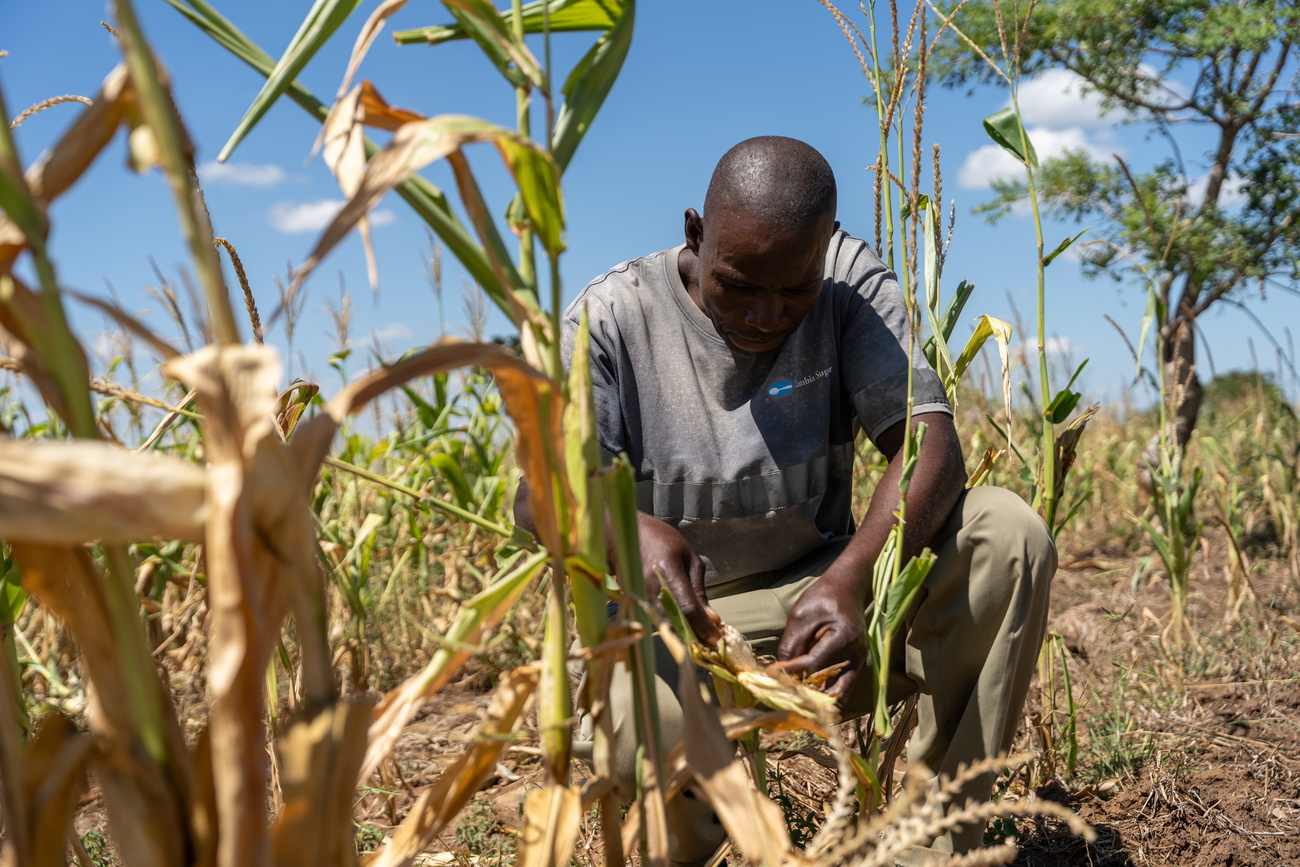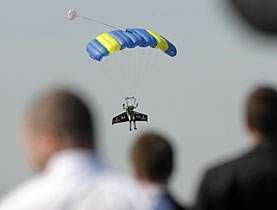Swiss pilots take skydivers to new heights

Two Swiss pilots have flown their Pilatus Porter plane from Biel all the way to the Himalayas to become part of the first ever Everest skydiving event.
Since October 2 Ruedi Isenschmid and Henri Schurch have been transporting skydivers up 8,990m in their tiny plane. But jumps were suspended on Wednesday as a mark of respect to 18 people killed when a plane crashed at the nearby Lukla airport.
Before the fatal crash, swissinfo caught up with Isenschmid at the dropzone. He had just come back down from his first flight to 8,990m, from where three people jumped becoming the first Everest skydivers in the world.
swissinfo: You have been a professional pilot for more than 30 years. How did this flight that took you higher than the world’s tallest mountain differ from you usual flying experience?
Ruedi Isenschmid: It was a very special and amazing experience. I fly a lot in the Swiss Alps but here you are much closer to the steering limit of the aircraft. The scenery is stunning and I saw peaks that trekkers can never see.
We flew very close to some of the 8,000m giants and also came very near Ama Dablam, the Matterhorn of Asia. However, the performance of the plane was less beautiful as it took us almost one hour to get to the required height.
swissinfo: You are just getting ready to take the next team of skydivers up. Is there a lot of pressure to perform as many flights as possible?
R.I.: We have to do as many flights as possible before the clouds come in and they normally build up in the valley in the morning. For the next flight I will take less fuel along to make the aircraft lighter as I will be taking four people.
swissinfo: What happens if the clouds come in whilst you are up there? Will you still be able to land at the tiny airstrip?
R.I.: As our plane does not use radar we need to literally see where we are landing and this is the big challenge. I have to observe the clouds closely and if they accumulate around the airstrip I have to land very quickly. However, once the airstrip is covered in cloud I either have to go down to the airport in Lukla or go all the way back to Kathmandu.
swissinfo: Is it normal for such a tiny plane to fly to almost 9,000m?
R.I.: We normally do not fly so high and for this event we needed special permits from the Swiss authorities. The jumpers and I are also using oxygen for this flight. The usual altitude for such an aircraft is about 3,000m to 4,000m.
swissinfo: As there are no Pilatus Porter planes in Nepal you flew it from Biel all the way to the Everest Region. How long did it take?
R.I.: The whole journey took us about 40 hours over five days. We flew from Heraklion all the way to Sharm el Sheikh over the Saudi Arabian desert to Bahrain, Muscat and then via India directly to Kathmandu.
swissinfo: What were the main challenges during that long flight?
R.I.: It is not easy to fly this small plane over such a distance. First of all, it has no autopilot, which means the pilot has to be extremely accurate. The co-pilot is normally responsible for navigating, communication and pumping fuel into the tanks, which keeps him very busy. And once these jobs are done he has to make sure the flying pilot is fed with Ragusa chocolate!
But I guess one of the biggest challenges was the fact that it was Ramadan when we hit the Middle East and we could not get a beer for four days!
When we flew over the Saudi desert we were caught in a sandstorm for about four hours and we could not see an inch. When we landed in Bahrain it was 40 degrees and we were very thirsty – but all we could get was warm water.
swissinfo: And what is the main challenge starting and landing at this tiny airstrip above Namche Bazaar?
R.I.: When we arrived on October 2 it was the first time ever that a Pilatus Porter plane had landed on this airstrip and getting it down was a real challenge. However, what was much more challenging was the introductory course my colleague Henri and I had to do in Kathmandu. The aviation authorities normally require four days of training but they granted us a crash course that took only 12 hours. It was all theoretical but the funny thing was that when I asked for the coordinates of the airstrip they did not know them.
swissinfo: How did you find this tiny airstrip without the coordinates?
R.I.: The authorities were able to give us the coordinates of the nearby Lukla airport and we found the airstrip using the tourist maps I had bought in Kathmandu.
swissinfo: You are flying and Henri is doing most of the work on the ground. Is he happy doing that?
R.I.: I think he is very lucky as he gets to work with the Nepali people, who are extremely helpful. They even put stones under the wheels to stop the aircraft but as they have never seen a plane like this it can be very dangerous for them.
Henri has to make sure they do not get too close to the propeller, he has to calculate the fuel, check the aircraft and lead the skydivers to the plane. He has a lot of work whilst I just fly the plane and enjoy the scenery!
swissinfo-interview: Billi Bierling in Kathmandu
On October 5, Holly Budge from Britain, Wendy Smith from New Zealand and Neil Jones from Canada became the first people to skydive in the Everest region in Nepal.
The skydivers were due to have finished their jumps within five days, however, bad weather and a tragic plane crash at the nearby airport in Lukla delayed the programme.
Thirty-two skydivers gathered at the airstrip above the Sherpa capital Namche Bazaar waiting for their turn to jump.
Some had a long wait since the Pilatus Porter plane can only carry four people at a time and takes almost one hour to reach the altitude of 8,990m.
Organiser Nigel Gifford said he first had the the idea for the event about 15 years ago and it had taken him two years to organise.

In compliance with the JTI standards
More: SWI swissinfo.ch certified by the Journalism Trust Initiative











You can find an overview of ongoing debates with our journalists here . Please join us!
If you want to start a conversation about a topic raised in this article or want to report factual errors, email us at english@swissinfo.ch.